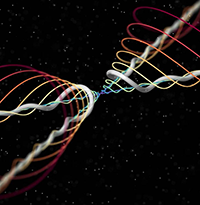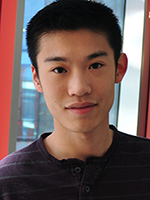Baltimore Sun Features Professor Gates
- Details
- Category: Department News
- Published: Friday, March 28 2014 09:19
Visit, http://ter.ps/58g, for the the full story.
Visit, http://ter.ps/58g, for the the full story.
 |
| Click image for information. |
Draining the water from a bathtub causes a spinning tornado to appear. The downward flow of water into the drain causes the water to rotate, and as the rotation speeds up, a vortex forms that obeys the laws of classical mechanics. However, if the water is extremely cold liquid helium, the fluid will swirl around an invisible line to form a vortex that obeys the laws of quantum mechanics. Sometimes, two of these quantum tornadoes flex into curved lines, cross over one another to form a letter X shape, swap ends, and then violently retract from one another—a process called reconnection.
Computer simulations have suggested that after the vortexes snap away from each other, they develop ripples called “Kelvin waves” to quickly get rid of the energy caused by the connection and relax the system. However, the existence of these waves had never been experimentally proven.
Now, for the first time, researchers provide visual evidence confirming that the reconnection of quantum vortexes launches Kelvin waves. The study, which was conducted at the University of Maryland, will be published the week of March 24, 2014 in the online early edition of the journal Proceedings of the National Academy of Sciences. The research was supported by the National Science Foundation.
“We weren’t surprised to see the Kelvin waves on the quantum vortex, but we were excited to see them because they had never been seen before,” said Daniel Lathrop, a UMD physics professor. “Seeing the Kelvin waves provided the first experimental evidence that previous theories predicting they would be launched from vortex reconnection were correct.”
Understanding turbulence in quantum fluids, such as ultracold liquid helium, may offer clues to neutron stars, trapped atom systems and superconductors. Superconductors, which are materials that conduct electricity without resistance below certain temperatures, develop quantized vortices. Understanding the behavior of the vortices may help researchers develop superconductors that remain superconducting at higher current densities.
Physicists Richard Feynman and Lars Onsager predicted the existence of quantum vortices more than a half-century ago. However, no one had seen quantum vortices until 2006. In Lathrop’s laboratory at UMD, researchers prepared a cylinder of supercold helium—at 2 degrees Celsius above absolute zero—injected with frozen tracer particles made from atmospheric air and helium gases. When they shined a laser into the cylinder, the researchers saw the particles trapped on the vortices like dew drops on a spider web.
“Kelvin waves on quantized vortices had been predicted, but the experiments were challenging because we had to conduct them at lower temperatures than our previous experiments,” explained Lathrop.
Since 2006, the researchers have used the same technique to further examine quantum vortexes. During an experiment in February 2012, they witnessed a unique reconnection event. One vortex reconnected with another and a wave propagated down the vortex. To quantitatively study the wave’s motion, the researchers tracked the position of the particles on the vortex. The resulting waveforms agreed generally with theories of Kelvin waves propagating from quantum vortexes.
“These first observations of Kelvin waves will surely lead to exciting new experiments that push the limits of our knowledge of these exotic quantum motions,” added Lathrop.
In the future, Lathrop plans to use florescent nanoparticles to investigate what happens near the transition to the superfluid state.
Lathrop conducted the current study with David Meichle, a UMD physics graduate student; Enrico Fonda, who was a research scholar at UMD and graduate student at the University of Trieste when the study was performed and is now a postdoctoral researcher at New York University; Nicholas Ouellette, who was a visiting assistant professor at UMD when the study was performed and is now an associate professor in mechanical engineering & materials science at Yale University; and Sahand Hormoz, a postdoctoral researcher at the University of California, Santa Barbara’s Kavli Institute for Theoretical Physics.
This research was supported by the National Science Foundation (NSF) under Award No. DMR-0906109. The content of this article does not necessarily reflect the views of the NSF.
The research paper, “Direct observation of Kelvin waves excited by quantized vortex reconnections,” Enrico Fonda, David P. Meichle, Nicholas T. Ouellette, Sahand Hormoz, and Daniel P. Lathrop, published the week of March 24, 2014 in the online early edition of the journal Proceedings of the National Academy of Sciences.

Geoffrey Ji has been awarded a scholarship by the Barry M. Goldwater Scholarship and Excellence in Education Foundation, which encourages students to pursue advanced study and careers in the sciences, engineering and mathematics. He is among the 283 students selected from 1,166 students nominated nationally this year. Ji—who is majoring in physics, mathematics, economics and computer science—has been conducting quantum science research for two years in the laboratory of Chris Monroe, Bice Zorn Professor of Physics.
“Geoffrey has almost single-handedly outfitted advanced digital and analog electronic control circuits, in addition to writing impressive computer code that will soon be adopted by most of our other projects,” said Monroe.
Ji also conducted theoretical nuclear physics research with Paulo Bedaque, associate professor of physics, which resulted in co-authorship of a peer-reviewed publication in the journal Physical Review D. He is a member of the UMD Honors College and plans to pursue a doctoral degree.
Maryland Physics was ranked 14th by U.S. News and World Report's 2015 Best Graduate Schools -- with four specialties in the top 10. Our rankings included:
| The plasma specialty ranked 3rd |
| The atomic/molecular/optical specialty ranked 6th |
| The quantum specialty ranked 8th |
| The condensed matter specialty ranked 10th |
| The cosmology/gravity/relativity specialty ranked 13th |
The College of Computer, Mathematical and Natural Sciences' full Best Graduate School rankings are available here.